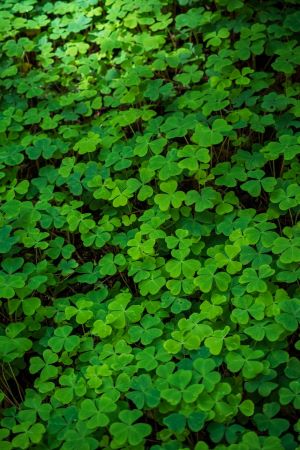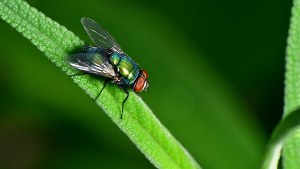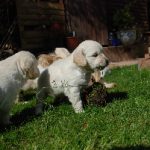
If your dogs are anything like mine then they spend enough time surrounded by grass- whether they are in the garden, at the park or in some fields at the top of my house.
And the interesting thing about grass is that it has other things growing amongst it.
And one of the things that appears on our lawns or in the park is clover.
Dogs aren’t fussy and when they start chomping on some grass they might also be ingesting some clover.
Is this something that we should worry about as dog owners or should we just roll our eyes, divert their attention and wait for the tell tale signs to appear in their stool a few days later?
Let’s find out shall we?
What is clover?
Clover has several different species with a varying range of chemicals in the plant. It is often used for animal feed, particularly for cattle.
Several types have escaped cultivation and can be found along roadsides, railway tracks and other places.
The varieties of clover found in the U.S. and the UK are primarily alsike, white and red.
There are several others that may be found in various places, but these are the most common.
Hop clover, also known as yellow clover, is better known in Europe but can be found in the U.S.
Is clover poisonous to dogs?
The answer to that is that it depends. Small amounts of most types of clover are unlikely to pose a lasting threat, particularly if only eaten occasionally. Large amounts, especially over time, could cause some serious problems.
Another thing to watch out for with clover is when it has been infested with fungus. The fungus that attack clover is toxic, and not just to dogs. It is best to make sure that any clover consumed is free of the fungus.
Each variety of clover has a different set of chemicals with potential for being a threat. White clover has a small amount a type of cyanide. Red clover has a type of estrogen and is more likely to be attacked by fungus.
Dogs rarely eat enough clover for it to be a problem. However, eating any moldy clover, particularly over a period of weeks, can be fatal. For small dogs, a mouthful or two a day could cause hemorrhaging. If you would prefer a clover lawn, find a variant that was designed not to attract the mold.
What are the symptoms of clover poisoning?
Some dogs may develop photosensitivity if they regularly eat clover. Light colored dogs are at the most risk for this. Larger amounts of clover could cause an enlarged, fibrous liver. Again, this is rare.
The worst problem is with the mold. This mold contains a strong blood thinner that will mess up the clotting time of your dog. Any scratch, lesion or internal problem could lead to blood loss. The longer the moldy clover is consumed, the worse the disease will get.
There are things veterinarians can do to help your pooch get over the problem, but avoiding it is the best bet. If you have a micro clover lawn, watch for signs of problems with the plants. Better yet, use a mold resistant variety.
The two treatments for sweet clover toxicity in dogs are a total blood transfusion and the administration of K1 and K3. These help right the clotting issue and will stop the problem from advancing to death.
What are the hidden dangers of dogs eating clover?
There are quite a few. In areas where fields are cultivated, lawns are grown or otherwise there is a strong chance of human interference, there is the possibility of both weed killers and chemical fertilizers. In the wilder areas or where certain animals are farmed, there could also be danger from the urine or droppings.
Weed killers, also known as herbicides, cause problems for humans as well as dogs. Most folks know about the problems one major brand of herbicide have caused. In humans, it has been known to cause cancer. It can do the same thing to dogs.
However, dogs have a more acute problem when they ingest weed killer. It doesn’t take that much to cause them neurological problems, diarrhea, nausea, vomiting, coma and death. Add in rodenticides and the list is even more problematic. That causes blood to cease clotting, excessive water drinking and eventually a painful death.
Why do dogs eat grass?
There are actually two questions in this… the other is “Why do people think dogs eat grass?” There are two schools of thought about this opinion question. The first is that dogs eat grass because they don’t feel well. The second is that the dogs enjoy the taste/texture.
The real answer is a lot more complicated. Not because there are complications from eating the grass, but because there are so many possible reasons. It is unlikely that dogs eat grass because they don’t feel well. Some dogs may throw up after eating it, but that doesn’t mean either that they were self-medicating or using it to force the issue.
Dogs are not obligate carnivores, though they are also not quite omnivores. This means that they do need some plant material in their diet, and if they aren’t getting enough fibrous stuff in their food, they may resort to munching on grass to fill that dietary need.
Before becoming domesticated, wild dogs and other canids hunted… and ate the whole thing when they caught something. This included (gross warning) the contents of the prey’s stomachs. This would often contain plant material such as grass, seeds, etc. In that way, they had a pretty balanced diet.
Dogs that are anxious or bored may take to eating grass. For them, it’s comfort food and something to do to while away the hours that their people are away. This can easily be discouraged, either with something to do or something that smells like their person.
It should be noted that nearly half of the wolf population also eats grass… and they are in the wild still. That makes it a natural thing for dogs to do. They are following their instincts.
Can dogs eat clover honey?
Small amounts of raw clover honey can be beneficial to your dog. The only caveat about honey is that too much of it can cause serious health issues. Never feed any type of honey to puppies.
Raw honey contains nutrients that help the gut health of your pet. Unfortunately, processed honey doesn’t have as many nutrients. It also usually has added sugars which can lead to obesity and pancreatitis. Check the label carefully when purchasing honey so that your dog gets the best for his or her needs.
In what other ways could gardens be dangerous for dogs?
There are a lot of plants that can be dangerous for your dog. The cyanide in stone fruit pits/seeds are one example. Plants in the nightshade family, including tomatoes, potatoes and peppers, have dangerous parts to them. It would be a good plan to check out the AKA poisonous plants page for more details.
There is another possible threat in your garden; slugs and snails. Some of them have parasites that can attack your dog’s digestive tract. Roundworms and tapeworms are two of them. These can be spread to the humans in your life… including you.
Mulch and compost can also be sources of trouble for your pet. Cacao mulch is a particular problem as it comes from the remnants of chocolate making. It has as much theobromine as regular chocolate and is just as unhealthy. Compost may contain mold and possible food poisoning to the mix, so be very careful if you uses homemade compost.
What other sprouts can dogs eat?
Bean and broccoli sprouts can be eaten in moderation. There may be others, including Brussels sprouts, which could be considered safe for dogs to eat. They can either be raw or cooked. Sprouts contain vitamins, minerals and fiber that help your pet stay healthy.
Can dogs eat healthy microgreens?
Microgreens are immature versions of regular plants. Most of the microgreens we humans eat work well for dogs. These include: broccoli, kale, leafy greens, mustard, cabbage, wheatgrass and even sunflower microgreens.
Microgreens are a step further along from sprouts; they have developed up to two inches in height. They contain more nutrients than the full grown version because this is the most rapid growth stage of the plants.
When working with mustard microgreens, don’t worry about toxicity. Yes, the seeds are toxic, but the greens themselves are safe and healthy. Do make sure all of the seeds have sprouted and grown, though.
Can dogs eat clover?
Yes, dogs can eat clover in moderation. Like most plant foods, dogs can only handle a certain percentage of plant food per day in their diets. For dogs this is around thirty six percent, though it is always wise to check with your vet for his or her recommendations.
Many plants are safe and healthy for your pet to eat. They can provide additional sources of important nutrients plus fiber to keep the digestive tract moving well. It is better for your pet if you choose which fruits, vegetables and/or nuts that your dog eats to avoid problems.
A bored or anxious dog may start to eat inappropriate things. It may not necessarily be grass. Our dog shreds his doggy bed when he’s bored, so we try to keep him from feeling that way. Your local pet store may have doggy puzzles with treats in them to help prevent both anxiety and boredom. Something you’ve worn could also be helpful.
Most of all, keep in mind that eating some grass is a perfectly normal thing for your dog to do. It is instinctive and not necessarily a bad thing.





